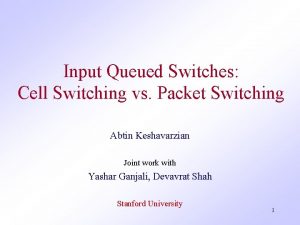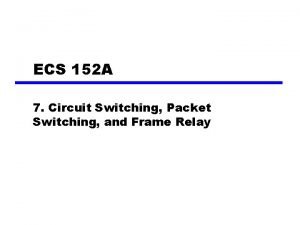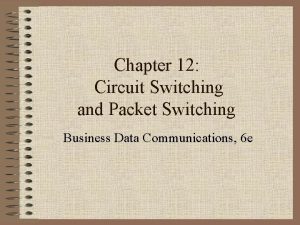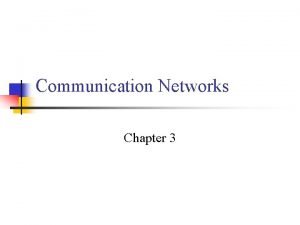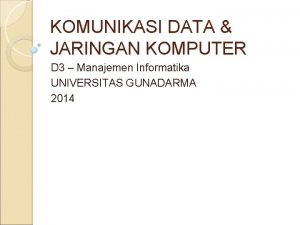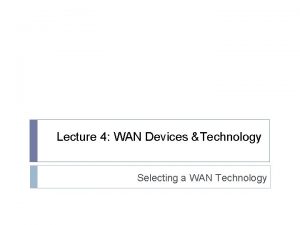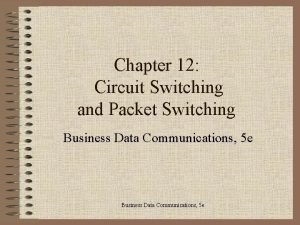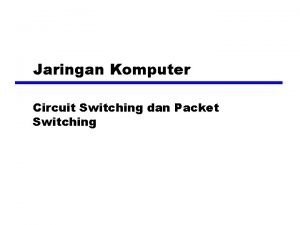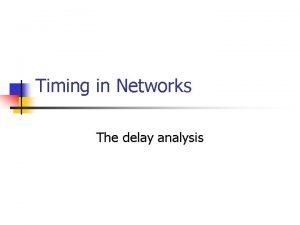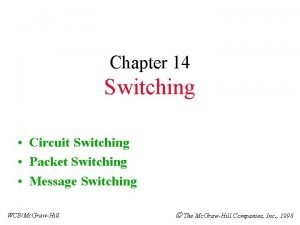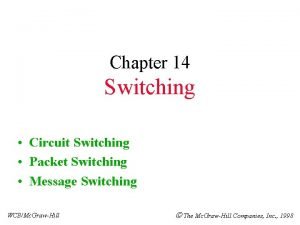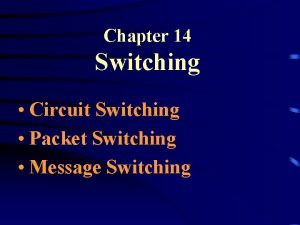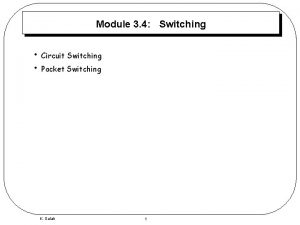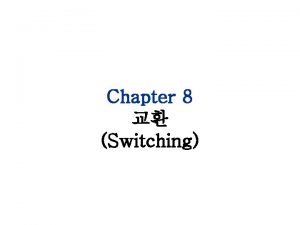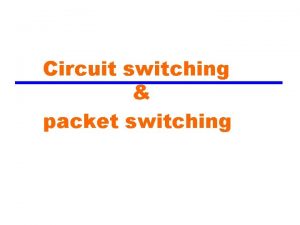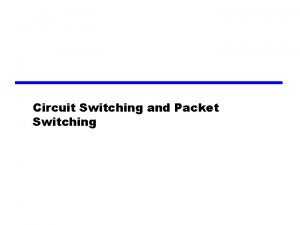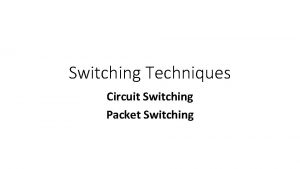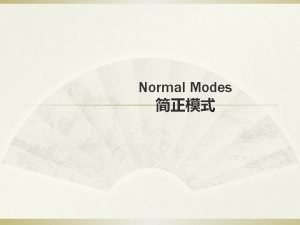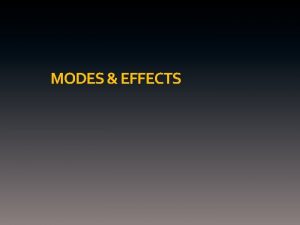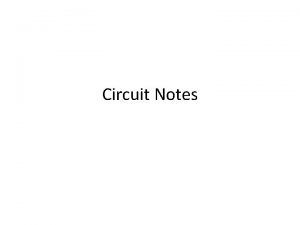Switching Fourth Meeting Switching Modes l Circuit Switching




























- Slides: 28

Switching Fourth Meeting

Switching Modes l Circuit Switching l l l Continuous link Exclusive Packet Switching l l l No continuous link Data is divided into packets Not exclusive Circuit Switching` Packet Switching`

Incurred Delay l Circuit-switched l l fixed delay of transferring data Packet-switched l l Queuing delays Variable transmission delay because of the capacity of the link. Hi Mom

Multiplexing l l It improve the efficient use of the transmission capacity of physical media Two types of multiplexing l l l Deterministic Statistical Deterministic Multiplexing l transmission medium is divided between a fixed number of communication channels

Statistical Multiplexing l l The multiplexer and demultiplexer do not perform any switching The multiplexer stores the incoming packets in a buffer. Why? l l l Data rates of the input channel and the multiplexed channel are different; and Packets may arrive simultaneously on several input channels. In the multiplexer, the packets are stored with a header with input channel number. In the demultiplexer, the packets are retrieved in reverse order The packet header identify the output channel. Buffers are required for each output channel l The demultiplexer, over a short period of time, receive packets at a faster data rate than it can transmit.

Switching Structures l Cross-points l l l It connect input lines to output lines with a dedicated crosspoint It is non-blocking Switching Arrays l single-stage switch connects one input line to an output line using a single cross-point

Switching Structures: 3 -Stage-Switching l Three stage-switching l Blocking occurs N inputs = m groups * n inputs l N outputs = m groups * n outputs l l The first stage l l m array switches. Each array switches l l l The second stage l l k array switches Each array switch l l l n input lines k output lines m input lines m output lines The third stage l l m array switches. Each array switches l l k input lines n output lines

How Many Cross Points l The total number of cross-points = l l First stage l l l Total = k × m Since m = N/n, Then Total = k × (N/n)2. Third stage (same as first stage) l l Total = n × k × m Since N = n × m, then Total = N × k Second stage l l number of cross-points in the first stage plus number in the second stage plus number in the third. Total = N × k All three stages l .

Three Stage Switching Example l l 6 input lines that is blocking. four first-stage arrays l l Each array hasfour input lines l l n=4 Five second-stage arrays l l m=4 k=5 16 × 16 three-stage configuration has l

Digital Space Switching l Two types l l l Digital space switching and Digital time switching. Digital space switching l l The first automatic telephone exchanges Paths were set up using electromagnetic devices

Space Switch Carries A Time Division Multiplexed (TDM)

Space Switch Multiplexer

Space Switch Multiplexer

Example Frame 50 51 52 60 61 62 70 71 72 Multiplex X Control 0 Input 0 Selects 0 = 0 Selects 1 = 0 Input 1 Input 2 Time Slot 0 0 Output 0 0 Multiplex Y 0 1 Selects

Example Frame 50 51 60 61 62 70 71 72 Multiplex X Control 0 Input 1 Input 2 Time Slot 1 1 Output 0 1 Multiplex Y 0 1 Selects

Example Frame 70 50 51 60 61 71 72 Multiplex X Control 0 Input 1 Input 2 Time Slot 2 3 Output 1 1 Multiplex Y 0 1 Selects

Example Frame 70 50 51 60 61 71 72 Multiplex X Control 0 Input 1 Input 2 Time Slot 3 2 Output 1 0 Multiplex Y 0 1 Selects

Time Switching

Time Switching Implementation l Use two memory devices l Speech store l All incoming data octets are stored in their sequence of arrival, § § l Octet 0 → location 0 Octet 1 → location 1 : Cyclic counter Connection store, l l Contains the destination outgoing lines Has a cyclic counter

Example Input Time Slot Output Time Slot 0 3 1 2 2 1 3 4 0 0 1 2 3 4 0 Counter 1 0 Counter 2 0 Time 3 0 1 2 3 4

Example Input Time Slot Output Time Slot 0 3 1 2 2 1 3 4 0 1 2 3 4 1 Counter 1 1 Counter 2 0 1 Time 3 2 0 1 2 3 4

Example Input Time Slot Output Time Slot 0 3 1 2 2 1 3 4 0 1 2 3 4 2 Counter 1 2 Counter 2 0 1 2 Time 3 2 1 0 1 2 3 4

Example Input Time Slot Output Time Slot 0 3 1 2 2 1 3 4 4 0 0 2 3 0 1 2 3 4 3 Counter 1 3 Counter 2 0 1 2 3 Time 3 2 1 4 0 1 2 3 4

Example Input Time Slot Output Time Slot 0 3 1 2 2 1 3 4 4 0 2 3 4 0 1 2 3 4 4 Counter 1 4 Counter 2 0 1 2 3 Time 4 3 2 1 4 0 0 1 2 3 4

Space Time Space Switching k=1 n=3

Packet Switching l l In the past, the delay associated with packet switching meant that it was not considered suitable for real-time applications such as voice communication. Packet-switching exchanges (PSEs) have used the concept of stored program control (SPC) since the first generation of exchanges, in the late 1960 s

2 nd and 3 rd Generation PSE

Cell Switching Virtual Path Switch 2 Virtual Path Switch 1 l Cell switching ≈ packet switching l l Cell switching ≠ packet switching l l Cells have a fixed size Cell switching ≈ circuit-switching l l l breaks a data stream into packets connection-oriented service virtual circuit created. Cell switching ≠ circuit-switching l l circuit is virtual No reserving of network resources Picture source http: //www. sce. carleton. ca/netmanage/dcomm. Tutorials/scan 0603. gif
 Circuit switching vs packet switching vs message switching
Circuit switching vs packet switching vs message switching Difference between circuit switching and packet switching
Difference between circuit switching and packet switching A switch in a datagram network uses
A switch in a datagram network uses Datagram network
Datagram network Cell switching vs packet switching
Cell switching vs packet switching Cell switching vs packet switching
Cell switching vs packet switching Packet
Packet Applications of circuit switching
Applications of circuit switching Each packet is treated independently
Each packet is treated independently Types of communication network are
Types of communication network are Perbedaan aloha dan lan
Perbedaan aloha dan lan Contoh circuit switching
Contoh circuit switching Private wan infrastructure
Private wan infrastructure Circuit switching types
Circuit switching types Rute
Rute Pengertian packet switching
Pengertian packet switching Timing datagram
Timing datagram Today meeting or today's meeting
Today meeting or today's meeting Today meeting or today's meeting
Today meeting or today's meeting What is meeting and types of meeting
What is meeting and types of meeting What is meeting and types of meeting
What is meeting and types of meeting Circulatory system diagram
Circulatory system diagram Series circuit vs parallel circuit
Series circuit vs parallel circuit Difference between complete and incomplete circuit
Difference between complete and incomplete circuit What is a parallel circuit in physics
What is a parallel circuit in physics Parallel circuit with 3 bulbs
Parallel circuit with 3 bulbs Short circuit in circuit diagram
Short circuit in circuit diagram Phet circuit construction kit
Phet circuit construction kit Series and parallel circuits similarities
Series and parallel circuits similarities




